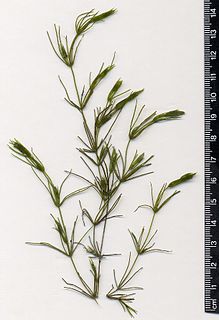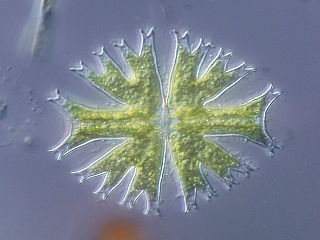
Charales is an order of freshwater green algae in the division Charophyta, class Charophyceae, commonly known as stoneworts. Linnaeus established the genus Chara in 1753.

Crassostrea is a genus of true oysters containing some of the most important oysters used for food. Some species in the genus have been moved to the genus Magallana.

Myxobolidae is a family of myxosporean parasites which typically infect freshwater fishes, and includes the economically significant species, Myxobolus cerebralis. They have been shown to have a complex life cycle, involving an alternate stage in an invertebrate, typically an annelid or polychaete worm.

Oedogonium is a genus of filamentous, free-living green algae, first discovered in the fresh waters of Poland 1860 by W. Hilse and later named by German scientist K. E. Hirn. The morphology of Oedogonium is unique, with an interior and exterior that function very differently from one another and change throughout its life cycle. These protists reside in freshwater ecosystems in both hemispheres and are both benthic and planktonic in nature. Forming algal patches on water's surface, they interact closely with a multitude of other algae. These filamentous cell's life cycles include both sexual and asexual reproduction, depending on life cycle stage. Although quite common, Oedogonium is difficult to identify, since key ID factors are only present during reproduction, which is an uncommon life stage among this genus. Oedogonium has been found to be important in the fixation of heavy metals in freshwater ecosystems.

Micrasterias is a unicellular green alga of the order Desmidiales. Its species vary in size reaching up to hundreds of microns.

Gastrodia, commonly known as potato orchids or as 天麻属 , is a genus of terrestrial leafless orchids in the family Orchidaceae, about ninety of which have been described. Orchids in this genus have fleshy, upright stems and small to medium-sized resupinate flowers with narrow sepals and petals. They are native to Asia, Australia, New Zealand, central Africa, and various islands of the Indian and Pacific Oceans.

Nitella is a genus of charophyte green algae in the family Characeae.

Baiera is a genus of prehistoric gymnosperms in the order Ginkgoales. It is one of the oldest fossil foliage types of Ginkgoales, and is related to the genera Ginkgo and Ginkgoites. Fossils of Baiera are found worldwide, and have been known from the Permian to the Cretaceous.
Thalassiothrix is a genus of Chromista belonging to the family Thalassionemataceae.

Achnanthidium is a genus of diatoms belonging to the family Achnanthidiaceae.
Achroonema is a genus of bacteria with uncertain systematics.
Eucapsis is a genus of cyanobacteria belonging to the family Merismopediaceae.
Eucocconeis is a genus of diatoms belonging to the family Achnanthidiaceae.
Eudesme is a genus of brown algae belonging to the family Chordariaceae.
Lochmaea is a genus of beetles belonging to the family Chrysomelidae.
Limnoperna is a genus of bivalves belonging to the family Mytilidae.








